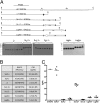Overlapping activation-induced cytidine deaminase hotspot motifs in Ig class-switch recombination
- PMID: 21709240
- PMCID: PMC3136278
- DOI: 10.1073/pnas.1018726108
Overlapping activation-induced cytidine deaminase hotspot motifs in Ig class-switch recombination
Abstract
Ig class-switch recombination (CSR) is directed by the long and repetitive switch regions and requires activation-induced cytidine deaminase (AID). One of the conserved switch-region sequence motifs (AGCT) is a preferred site for AID-mediated DNA-cytosine deamination. By using somatic gene targeting and recombinase-mediated cassette exchange, we established a cell line-based CSR assay that allows manipulation of switch sequences at the endogenous locus. We show that AGCT is only one of a family of four WGCW motifs in the switch region that can facilitate CSR. We go on to show that it is the overlap of AID hotspots at WGCW sites on the top and bottom strands that is critical. This finding leads to a much clearer model for the difference between CSR and somatic hypermutation.
Conflict of interest statement
The authors declare no conflict of interest.
Figures





References
-
- Yu K, Lieber MR. Nucleic acid structures and enzymes in the immunoglobulin class switch recombination mechanism. DNA Repair (Amst) 2003;2:1163–1174. - PubMed
-
- Chaudhuri J, Alt FW. Class-switch recombination: Interplay of transcription, DNA deamination and DNA repair. Nat Rev Immunol. 2004;4:541–552. - PubMed
-
- Gritzmacher CA. Molecular aspects of heavy-chain class switching. Crit Rev Immunol. 1989;9(3):173–200. - PubMed
-
- Kataoka T, Miyata T, Honjo T. Repetitive sequences in class-switch recombination regions of immunoglobulin heavy chain genes. Cell. 1981;23:357–368. - PubMed
Publication types
MeSH terms
Substances
Grants and funding
LinkOut - more resources
Full Text Sources
Other Literature Sources

